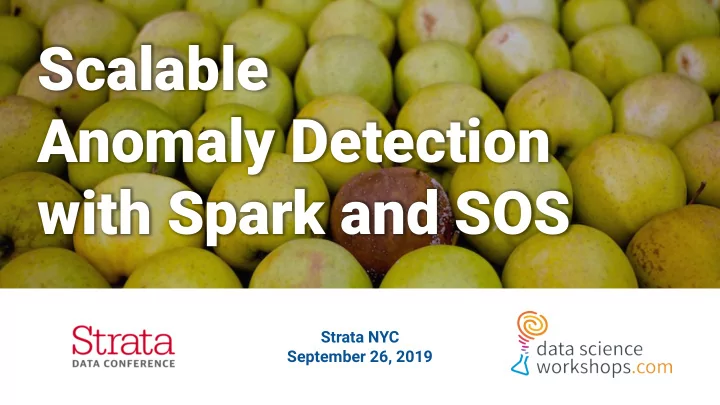

Scalable Anomaly Detection with Spark and SOS Strata NYC September 26, 2019
Hi there, my name is Jeroen Janssens
Today ● SOS, World! ● Anomalies and outliers ● Evaluating outlier-selection algorithms ● Various approaches to outlier selection ● Stochastic Outlier Selection ● Conclusion
SOS, World! 01-sos-world.ipynb
Implementations of SOS ● Python: http://bit.ly/sos-python ● Spark: http://bit.ly/sos-spark ● R: http://bit.ly/sos-r ● Flink: http://bit.ly/sos-flink
Anomalies and outliers
An anomaly is an observation or event that deviates qualitatively from what is considered to be normal, according to a domain expert.
Detecting anomalies is important ● Expensive ● Dangerous Mess up your model ●
Human anomaly detection may suffer from ● Fatigue ● Information overload Emotional bias ●
Feature-vector representation
Dissimilarity-matrix representation
From anomaly to outlier
An outlier is a data point that deviates quantitatively from the majority of the data points, according to an outlier-selection algorithm.
The symbiotic relationship between the domain expert and the algorithm
Data flow diagram Data flow diagram illustrating the relationship between the domain expert (square) and the outlier-selection algorithm (top circle).
Six Euler diagrams (1/2)
Six Euler diagrams (2/2)
Evaluating outlier-selection algorithms
Confusion matrix Computer says no.
Four possible outcomes
Evaluation Illustration of relabelling a multi-class data set into multiple one-class data sets.
Anomalies are rare In order to evaluate the algorithm we simulate anomalies to be rare. Banana for scale.
Outlier scores The dashed line indicates the threshold chosen by the domain expert.
ROC curve An ROC curve plots the false alarm rate against the hit rate for all possible thresholds.
Various approaches to outlier selection
Distribution-based outlier selection
Distance-based outlier selection Size does matter
Density-based outlier-selection
Stochastic Outlier Selection
Stochastic Outlier Selection ● Unsupervised outlier selection algorithm ● Employs concept of affinity (inspired by t-SNE) One parameter: perplexity ● Computes outlier probabilities ●
t-Distributed Neighbor Embedding (t-SNE; Van der Maaten, Hinton) employs affinity to perform dimensionality reduction
A data point is selected as an outlier when all the other data points have insufficient affinity with it.
From input to output
From feature matrix to dissimilarity matrix
From input to output
Smooth neighborhoods
Affinity between data points
From input to output
From affinity to binding probability The binding matrix B is obtained by normalising each row in the affinity matrix A.
Binding probabilities form a graph
Binding probabilities form a graph
Stochastic Neighbor Graph A data point belongs to the outlier class when no it is not selected by any other data points.
Three SNGs The three SNGs Ga, Gb, and Gc are sampled from the discrete probability distribution P(G).
Set of all SNGs
Approximating outlier probabilities by sampling SNGs
Demo: Sampling SNGs in CoffeeScript and D3 http://bit.ly/sos-d3
Computing outlier probabilities through marginalisation
Computing outlier probabilities in closed form
Proof!
Selecting outliers
Adaptive variances via the perplexity parameter
Continuous binary search
Perplexity influences outlier probabilities
Evaluation and comparison
Putlier-score plots
Real-world datasets
Synthetic datasets
Synthetic datasets
Synthetic datasets
Synthetic datasets
SOS performs significantly better
Spark implementation of SOS
Spark implementation of SOS ● Developed by Fokko Driesprong ● Works with DataFrame API ● Available on GitHub ● Plan is to make it part of MLLib
SOS on PySpark 92-pyspark-sos.ipynb
Summary Outlier selection can support the detection of anomalies ● SOS is an intuitive and probabilistic algorithm to select outliers ● SOS has a very good performance ● No free lunch ●
Thank you! Here are some links ● Blog: http://bit.ly/sos-blog ● D3 Demo: http://bit.ly/sos-d3 ● Python implementation: http://bit.ly/sos-python ● Spark implementation: http://bit.ly/sos-spark ● R implementation: http://bit.ly/sos-r ● Flink implementation: http://bit.ly/sos-flink
Recommend
More recommend